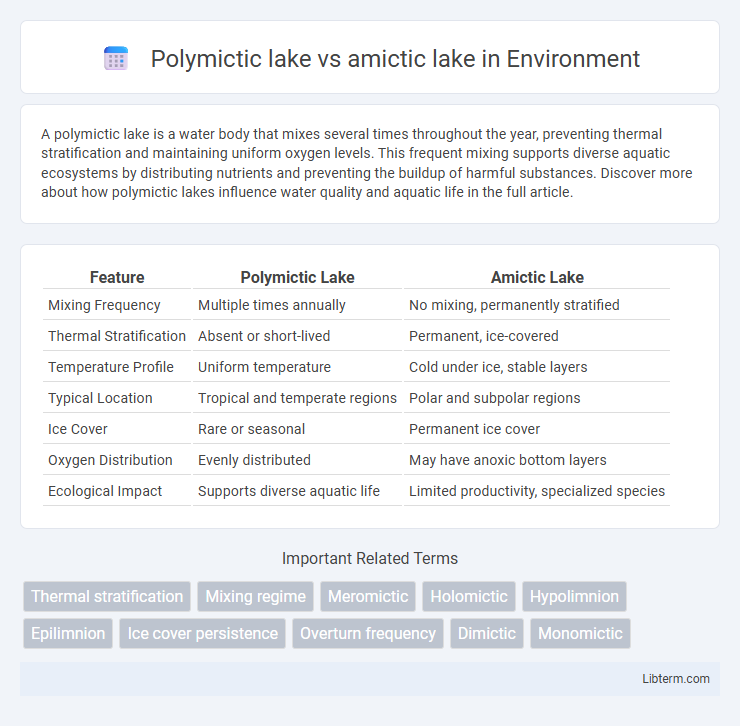A polymictic lake is a water body that mixes several times throughout the year, preventing thermal stratification and maintaining uniform oxygen levels. This frequent mixing supports diverse aquatic ecosystems by distributing nutrients and preventing the buildup of harmful substances. Discover more about how polymictic lakes influence water quality and aquatic life in the full article.
Table of Comparison
| Feature | Polymictic Lake | Amictic Lake |
|---|---|---|
| Mixing Frequency | Multiple times annually | No mixing, permanently stratified |
| Thermal Stratification | Absent or short-lived | Permanent, ice-covered |
| Temperature Profile | Uniform temperature | Cold under ice, stable layers |
| Typical Location | Tropical and temperate regions | Polar and subpolar regions |
| Ice Cover | Rare or seasonal | Permanent ice cover |
| Oxygen Distribution | Evenly distributed | May have anoxic bottom layers |
| Ecological Impact | Supports diverse aquatic life | Limited productivity, specialized species |
Introduction to Lake Mixing Types
Polymictic lakes experience frequent mixing events throughout the year due to shallow depths and variable temperature regimes, preventing stable thermal stratification. Amictic lakes remain ice-covered year-round and lack mixing, maintaining stable water layers with limited oxygen circulation. Understanding these contrasting lake mixing types is essential for assessing aquatic ecology, nutrient cycling, and thermal dynamics in freshwater systems.
Defining Polymictic Lakes
Polymictic lakes are characterized by frequent mixing of their water layers throughout the year, preventing thermal stratification and ensuring uniform temperature and oxygen distribution. These lakes typically occur in shallow, tropical or subtropical regions where temperature fluctuations are moderate, and wind-driven mixing is strong. Unlike amictic lakes, which remain perpetually ice-covered and do not mix, polymictic lakes support diverse aquatic ecosystems due to their continuous circulation.
Defining Amictic Lakes
Amictic lakes are characterized by their permanent ice cover, preventing any seasonal mixing of the water column and maintaining stable stratification throughout the year. Unlike polymictic lakes, which experience frequent mixing events due to temperature fluctuations, amictic lakes remain isolated from atmospheric influences, resulting in unique ecological and chemical conditions. These lakes are typically found in polar regions where extreme cold maintains the ice cover, creating distinct habitats for specialized aquatic organisms.
Key Physical Differences
Polymictic lakes experience frequent mixing throughout the year due to their shallow depth and warm temperatures, preventing stable thermal stratification. Amictic lakes remain permanently stratified under a thick ice cover, with no mixing occurring during the year because temperatures stay below freezing. The primary physical distinction lies in polymictic lakes' continual overturn versus amictic lakes' persistent ice cover and stable, unmixed water layers.
Geographic Distribution of Polymictic and Amictic Lakes
Polymictic lakes are typically found in tropical and subtropical regions where frequent temperature fluctuations prevent thermal stratification, leading to continuous mixing throughout the year. Amictic lakes are commonly located in polar and high-altitude areas, such as Antarctica and alpine regions, where permanent ice cover prevents mixing and results in stable, ice-covered water columns. Geographic distribution correlates strongly with climatic conditions, influencing the thermal behavior and mixing patterns of these lake types.
Seasonal Mixing Patterns
Polymictic lakes experience multiple mixing events throughout the year due to frequent temperature fluctuations, preventing thermal stratification and allowing oxygen and nutrients to circulate continuously. Amictic lakes remain permanently ice-covered, especially in polar regions, inhibiting any seasonal mixing and maintaining stable, stratified conditions beneath the ice. These distinct seasonal mixing patterns significantly influence aquatic life and biogeochemical processes within each lake type.
Ecological Implications
Polymictic lakes experience frequent mixing throughout the year, resulting in uniform temperature and oxygen levels that support diverse aquatic life and enhance nutrient distribution. Amictic lakes remain permanently ice-covered, limiting oxygen exchange and light penetration, which restricts primary productivity and often leads to anoxic conditions below the ice. These contrasting mixing regimes significantly influence the biological communities, nutrient cycling, and overall ecosystem dynamics within each lake type.
Water Quality and Temperature Stratification
Polymictic lakes experience frequent mixing throughout the year, preventing stable thermal stratification and often leading to uniform oxygen and nutrient distribution, which can enhance overall water quality by reducing anoxic zones. Amictic lakes remain ice-covered year-round, preventing surface water mixing and resulting in permanent temperature stratification below the ice, which can cause oxygen depletion and nutrient stratification that impact water quality negatively. The contrasting mixing regimes between polymictic and amictic lakes fundamentally influence their temperature profiles and dissolved oxygen dynamics, directly affecting aquatic ecosystems and water quality parameters.
Human Impact and Management Challenges
Polymictic lakes, with frequent mixing and oxygen distribution, are more susceptible to pollution from agricultural runoff and urban waste, requiring continuous monitoring and pollutant source control for effective management. Amictic lakes, often found in polar regions with permanent ice cover, face unique challenges due to limited oxygen replenishment and sensitivity to climate change, demanding specialized strategies to protect their fragile ecosystems from global warming and human disturbances. Both lake types require tailored management approaches to mitigate human impact while preserving aquatic biodiversity and water quality.
Conclusion: Comparing Polymictic and Amictic Lakes
Polymictic lakes experience frequent mixing throughout the year, resulting in uniform temperature and oxygen distribution, which supports diverse aquatic ecosystems. Amictic lakes remain permanently stratified with no turnover, typically found in polar regions where ice cover prevents mixing, limiting oxygen replenishment in deeper layers. The ecological dynamics and biogeochemical processes differ significantly, making lake classification essential for understanding habitat conditions and ecosystem management.
Polymictic lake Infographic

 libterm.com
libterm.com